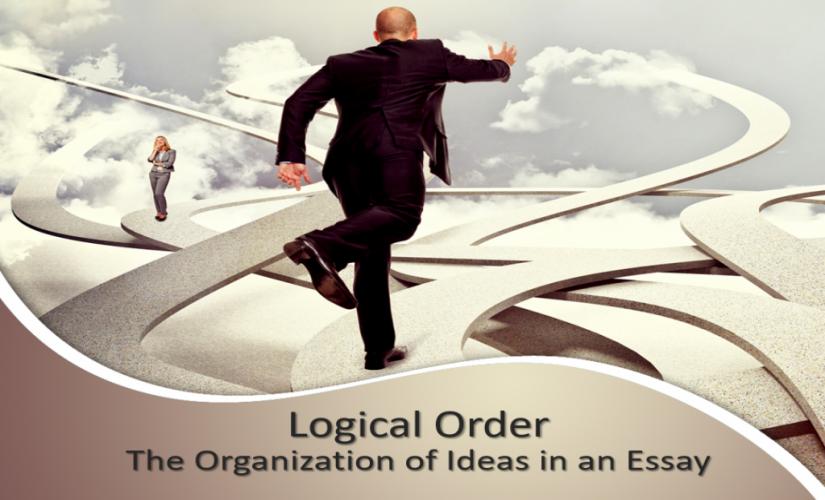The primary purpose of writing is to communicate views and ideas. Basically, learners organize written pieces in a way that gives meaning. In this case, a functional organization of sentences in paragraphs helps readers to follow a clear development of thoughts. Besides, such a method allows authors to deliver written works that meet academic standards. Hence, a logical order is a coherent organization of ideas from general to specific, which enhances an overall quality of papers.
What Is a Logical Order and Its Purpose in Writing
According to its definition, a logical order in writing is a structured and coherent arrangement of ideas and thoughts in a way that enhances understanding and readability for a reader. This way of presenting ideas also ensures each point builds upon a previous one, creating a clear and persuasive argument. For example, the primary purpose of writing in a logical order is to facilitate effective communication by presenting different themes in a manner that makes sense and supports an overall argument or narrative (Minto, 2021). This method of organization not only aids in preventing confusion but also enhances an overall persuasiveness and impact of writing. Moreover, when writing in a logical order, authors can ensure their message is conveyed clearly, making it easier for target readers to understand the key points and follow a natural progression of ideas (Barroga & Matanguihan, 2021). A good practice is to incorporate how to write thesis acknowledgement to maintain a structured approach. Whether in essays, research papers, reports, or creative writing, logical order is fundamental in conveying information clearly and persuasively.
Format
| Section | Content |
|---|---|
| Introduction | Introduce your main topic or argument. |
| Provide background information. | |
| State your thesis or main point. | |
| Body Paragraph 1 | Topic sentence introducing your first main idea. |
| Supporting details and evidence. | |
| Explanation of how the evidence supports your first main idea. | |
| Transition to a next paragraph. | |
| Body Paragraph 2 | Topic sentence introducing your second main idea. |
| Supporting details and evidence. | |
| Explanation of how the evidence supports your second main idea. | |
| Transition to a next paragraph. | |
| Body Paragraph 3 | Topic sentence introducing your third main idea. |
| Supporting details and evidence. | |
| Explanation of how the evidence supports your third main idea. | |
| Transition to a next paragraph. | |
| Conclusion | Restate your thesis or main point. |
| Summarize key points discussed in your body. | |
| Provide a final thought or call to action. |

Steps for Writing in Logical Order
- Identify Your Main Idea: Determine a central argument or thesis of your writing.
- Create an Outline: Draft an outline that organizes your main points in a logical sequence.
- Start With an Engaging Introduction: Introduce your topic, provide background information, and present your thesis statement.
- Organize Body Paragraphs: Begin each body paragraph with a specific topic sentence that states a single main theme.
- Use Transitions Effectively: Use transitional words and phrases and link your points between paragraphs and sections.
- Support Each Point With Evidence: Provide relevant evidence, examples, statistics, or quotes to back up each main aspect.
- Analyze and Explain: Analyze and explain how the evidence supports your point, reinforcing a logical progression.
- Address Counterarguments: Consider and logically refute potential counterarguments or alternative perspectives.
- Conclude Effectively: Summarize your central points, restate a thesis sentence, and provide a final thought or call to action.
- Review and Revise: Review your work to ensure logical flow and revise sections where needed for clarity and coherence.
Essay Organization Types
| Type | Description | Purpose | Common Uses |
|---|---|---|---|
| Logical (Topical) Order | Divides an assigned topic into subtopics, arranging them by importance, complexity, or other logical criteria. | To present ideas in a structured and coherent manner. | Expository essays, research papers. |
| Chronological Order | Arranges things according to a specific sequence in which events occur. | To narrate events in a particular order they happened. | Historical essays, biographies, narratives. |
| Spatial Order | Organizes information according to a physical location or relationship. | To describe a physical layout or arrangement of a place or object. | Descriptive essays, architectural reviews. |
| Cause and Effect | Explores possible causes of a particular event or situation and its resulting effects. | To analyze reasons and outcomes. | Analytical essays, scientific reports. |
| Problem and Solution | Identifies a problem and proposes one or more solutions, often discussing the advantages and disadvantages of each solution. | To address an issue and suggest solutions. | Persuasive essays, policy proposals. |
| Comparison and Contrast | Examines similarities and differences between two or more subjects. | To highlight distinctions and parallels. | Comparative essays, literature reviews. |
| Order of Importance | Arranges subjects in accordance to their significance, typically from least to most important, or vice versa. | To prioritize information and build up to a strong conclusion. | Persuasive essays, argumentative essays. |
| Classification and Division | Breaks down a broad topic into lower categories or groups and explains each category. | To organize complex information into understandable parts. | Analytical essays, informational essays. |
| Narrative Order | Tells a story or recounts events, focusing on a specific progression of a particular plot. | To engage readers with a compelling story. | Personal essays, creative writing. |
| Process Order | Explains some steps or stages involved in doing something or achieving a result. | To instruct or explain how something is done. | How-to essays, instructional manuals. |
Organizing Specific Ideas
A logical order requires learners to organize ideas from general to specific. For example, students make a general statement and then provide explanations (Firth et al., 2021). In this case, authors must ensure readers can understand described concepts. Besides, they must explain one theme exhaustively before moving to a next paragraph. In turn, authors must follow a natural sequence when writing. Finally, a proper flow of information relies on a useful classification of concepts. Therefore, successful learners organize their thoughts logically by making general claims followed by specific details.
Thesis Statement for Presenting Information
Well-organized papers encourage learners to develop an effective thesis statement. For instance, exceptional essays rely on a unique central argument (Minto, 2021). In this case, students develop a general claim in their introduction. Besides, each body paragraph must support one main idea, covering a logical order. Thus, the need to organize thoughts logically encourages writers to develop strong thesis statements.
Following a Logical Order
A correct logical order improves an overall quality of paragraphs in essays. For example, effective papers have paragraphs that deal with a single idea (Shapiro & Kissel, 2022). In this case, a first sentence in a section makes a general statement related to a central assertion. Then, other parts of a passage contain supporting examples and explanations. Besides, one should provide a transition to the different parts of an essay. Thus, following well-organized points in writing encourages students to shape a general quality of academic papers through effective subsections.
Enhancing Quality
A good logical order enables writers to enhance an entire quality of written papers by organizing concepts from known to new. For instance, capable learners communicate novel ideas and place them in a right context (Mensh & Kording, 2017). In this case, one should explain familiar concepts followed by unknown thoughts. In turn, a target audience can develop a better understanding of various concepts. Therefore, researchers can express new concepts to readers through logical organization.
Consistency
A logical order method helps learners to improve a particular tone of academic essays through consistency. For example, capable learners rely on a uniform writing style (Putra et al., 2023). In this case, authors must develop complete and clear sentences that enhance an overall meaning of a single paragraph. Besides, writers use similar grammatical structures throughout papers. Then, citing references determines an uniformity of one’s work. In turn, students should use the same style to acknowledge materials used to support arguments. Finally, this approach enhances an overall credibility of written pieces. As such, authors who utilize consistency improve written articles through uniformity of sentences and citations.
Common Mistakes
- Lack of a Clear Thesis: Failing to present a clear main argument or point at the beginning can confuse readers about a primary purpose of your writing.
- Weak Transitions: Poor or absent transitional phrases between paragraphs and sections can disrupt a natural flow and make your writing feel disorganized.
- Irrelevant Information: Including details that do not support your main point can distract readers and weaken an overall argument.
- Inconsistent Structure: Changing an organizational pattern mid-way, such as switching from chronological order to thematic order, can confuse readers.
- Overloading Paragraphs: Packing too many themes into a single paragraph can overwhelm readers and disorganize a main point.
- Repetition: Repeating same points without adding new insights can make your writing boring to read.
- Ignoring Counterarguments: Failing to address and refute counterarguments can make your writing appear one-sided, biased, and less persuasive.
- Weak Evidence: Using insufficient or weak evidence to support main points can undermine an argument’s credibility.
- Poor Conclusion: A conclusion that merely repeats an introduction paragraph or fails to provide closure can leave readers unsatisfied.
- Grammar and Syntax Errors: Grammatical mistakes and poor sentence structure can distract readers and obscure a logical flow of ideas.
Summing Up
In conclusion, successful learners unify written works to ensure they meet a right quality. Basically, a logical order technique refers to a defined organization of discussed points from general to specific. In this case, students develop a thesis statement, which is a comprehensive claim. Besides, authors must provide accurate details to support a central argument. In turn, this approach helps writers to organize concepts and ideas to achieve a unique flow. On the other hand, organizing papers logically enhances their overall quality.
References
Barroga, E., & Matanguihan, G. J. (2021). Creating logical flow when writing scientific articles. Journal of Korean Medical Science, 36(40), 1–14. https://doi.org/10.3346/jkms.2021.36.e275
Firth, K., Connell, L., & Freestone, P. (2021). Your PhD survival guide: Planning, writing and succeeding in your final year. Routledge.
Mensh, B., & Kording, K. (2017). Ten simple rules for structuring papers. PLOS Computational Biology, 13(9), 1–9. https://doi.org/10.1371/journal.pcbi.1005619
Minto, B. (2021). The pyramid principle: Logic in writing and thinking. Pearson Education Limited.
Putra, J. W., Teufel, S., & Tokunaga, T. (2023). Improving logical flow in English-as-a-foreign-language learner essays by reordering sentences. Artificial Intelligence, 320, 1–24. https://doi.org/10.1016/j.artint.2023.103935
Shapiro, S., & Kissel, T. K. (2022). Classical first-order logic. Cambridge University Press.


